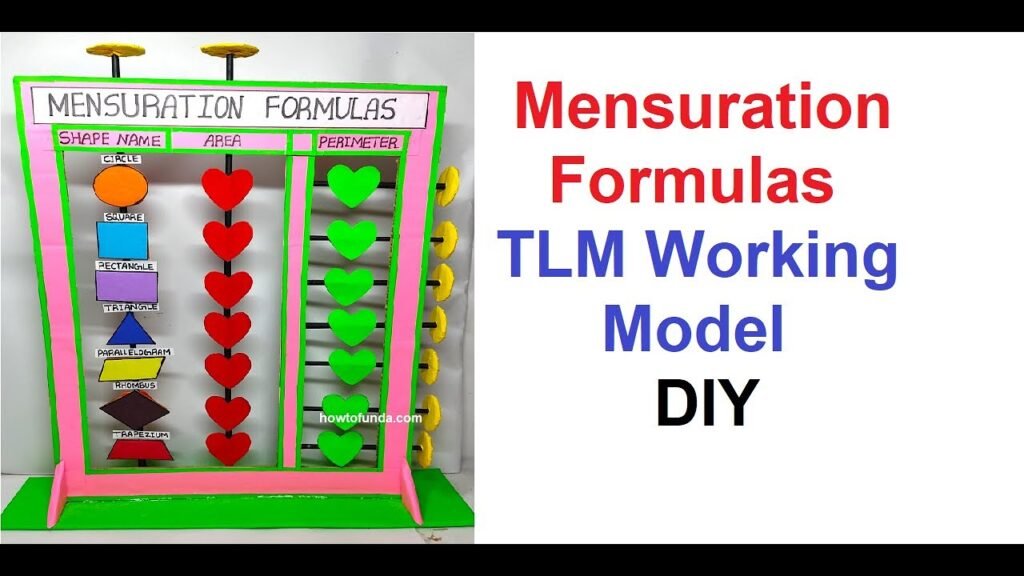Creating working models based on mensuration (the mathematical study of geometric shapes, areas, and volumes) can be both educational and fun.

Here are 25 ideas for working models that illustrate various concepts in mensuration:
Basic Shapes and Their Properties
- 2D Shapes and Area Calculation:
- Materials: Cardboard, markers, ruler.
- Description: Create cut-outs of different 2D shapes (square, rectangle, triangle, circle) and demonstrate how to calculate their areas.
- 3D Shapes and Volume Calculation:
- Materials: Cardboard, glue, scissors.
- Description: Construct models of different 3D shapes (cube, cuboid, cylinder, cone, sphere) and demonstrate how to calculate their volumes.
- Pythagorean Theorem Model:
- Materials: Cardboard, string, markers.
- Description: Build a right triangle model to show the relationship between the sides using the Pythagorean theorem.
- Area of a Triangle Using Heron’s Formula:
- Materials: Cardboard, string, markers.
- Description: Create a model to demonstrate Heron’s formula for calculating the area of a triangle given its sides.
- Surface Area of a Cylinder:
- Materials: Paper, tape, markers.
- Description: Construct a cylindrical model and show how to calculate its surface area.
Intermediate Models
- Volume of a Sphere:
- Materials: Styrofoam ball, string, markers.
- Description: Demonstrate the formula for the volume of a sphere using a Styrofoam ball.
- Volume of a Cone:
- Materials: Paper, tape, markers.
- Description: Create a cone model and explain the formula for calculating its volume.
- Surface Area and Volume of a Pyramid:
- Materials: Cardboard, glue, markers.
- Description: Construct a pyramid model and demonstrate how to calculate its surface area and volume.
- Composite Figures:
- Materials: Cardboard, scissors, glue.
- Description: Build models of composite figures (e.g., a shape combining a rectangle and a triangle) and show how to find their areas and volumes.
- Frustum of a Cone:
- Materials: Paper, tape, markers.
- Description: Create a frustum model and explain how to calculate its volume and surface area.
Advanced Models
- Archimedes’ Principle:
- Materials: Water, container, objects of different shapes.
- Description: Demonstrate buoyancy and volume displacement with various objects to explain Archimedes’ principle.
- Geodesic Dome:
- Materials: Straws, connectors, glue.
- Description: Construct a geodesic dome to demonstrate the calculation of surface area and volume in complex structures.
- Irregular Shapes and Approximation Methods:
- Materials: Grid paper, scissors.
- Description: Show how to approximate the area of irregular shapes using grid paper and counting methods.
- Volume of an Ellipsoid:
- Materials: Clay, string, markers.
- Description: Create an ellipsoid model and demonstrate how to calculate its volume.
- Surface Area of a Torus:
- Materials: Clay, string, markers.
- Description: Model a torus and explain the formula for its surface area.
Creative and Interactive Models
- Scaling Shapes:
- Materials: Cardboard, markers, scissors.
- Description: Demonstrate how scaling affects the area and volume of shapes by creating scaled-up and scaled-down models.
- Real-life Applications of Mensuration:
- Materials: Various household items.
- Description: Use everyday objects (e.g., cans, boxes) to demonstrate mensuration concepts in real life.
- Tessellation Patterns:
- Materials: Cardboard, markers.
- Description: Create tessellation patterns to show how shapes can cover a plane without gaps.
- Interactive Area Calculation Game:
- Materials: Board, shapes, markers.
- Description: Develop a game where students can place shapes on a board and calculate the area covered.
- Coordinate Geometry Models:
- Materials: Graph paper, markers.
- Description: Plot shapes on graph paper to demonstrate the calculation of area and perimeter using coordinates.
Large-Scale Models
- Model of a Sports Field:
- Materials: Cardboard, markers, scale ruler.
- Description: Create a scale model of a sports field and calculate its area and perimeter.
- Building Volume Model:
- Materials: Cardboard, glue, markers.
- Description: Construct a model of a building to demonstrate the calculation of its volume and surface area.
- Topographical Map and Area Calculation:
- Materials: Cardboard, markers, string.
- Description: Create a topographical map model and calculate the areas of different regions.
- Urban Planning Model:
- Materials: Cardboard, glue, markers.
- Description: Build a model of a city block to demonstrate the use of mensuration in urban planning.
- 3D Printing of Geometric Shapes:
- Materials: 3D printer, filament.
- Description: Use a 3D printer to create models of geometric shapes and calculate their volumes and surface areas.

